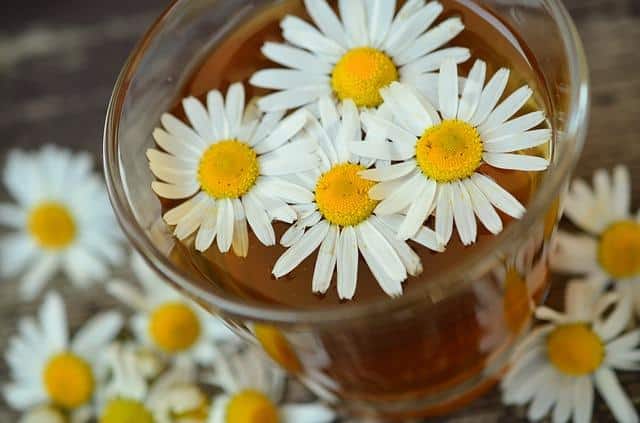Chamomile, a common herb used in teas, can calm muscle spasms, relieve menstrual cramps, ease nerves, soothe an upset stomach, promote healthy skin and even help you sleep.
Even better: It is a beautiful, flowering herb that can easily be grown outdoors and indoors.
There are two kinds of chamomile: Roman chamomile (Chamaemelum nobile) and German chamomile (Matricaria recutita). Both kinds have similar health properties and produce white and yellow daisy-like flowers. The steps for growing either variety of chamomile are the same, and the only difference is how the plants grow. Roman chamomile is a perineal and a low-growing plant, flowering close to the ground and can act as a ground cover. German chamomile is an annual seeding plant and grows to be one to two feet tall.
Looking For Non-GMO Chamomile Seeds? Get Them From A Company You Can Trust!
Either variety of chamomile thrives well outdoors in a garden or flower bed, and indoors in a pot. Growing chamomile indoors provides a lovely, fragrantly sweet house plant that can be harvested for teas, tinctures and salves.
Growing And Harvesting Chamomile Indoors
1. Planting chamomile seeds
- Obtain chamomile seeds from your previous plants, at a local nursery, or online.
- Select a pot and make sure the pot is large enough to support an adult plant. A suitable pot should be at least about 12 inches (30 centimeters) in diameter and have good drainage.
- You can sow the seeds directly in the potting soil, in the pot you intend to use, about two inches apart.
- Chamomile seeds need light to germinate. Therefore, lightly moisten the potting soil and lightly press the seeds into the soil so that they are still visible.
- After planting, keep the soil lightly moistened to dry. You can even mist the seeds with a spray bottle. Do not overwater.
2. Control the growing environment
- Place the pot near a south-facing window that gets at least four hours of sunlight per day.
- Chamomile seeds germinate best at temperatures of 68 degrees Fahrenheit (20 degrees Celsius).
- If your house is too cold, you can place them near your heat source.
- Keep the soil moist to dry during the germination process, as well. Again, you can mist them with a spray bottle.
- The seeds should sprout in about two weeks.
3. Caring for indoor chamomile plants
- Keep your plants near a south-facing window.
- Water about once a week, ensuring the soil remains moist, but do not allow it to become swampy.
- Don’t over fertilize your plant. Chamomile does well with little fussing. Too much fertilizer will result in fewer and weak-flavored flowers.
- Remember that chamomile plants are actually drought-tolerant.
- After two to three months, the plants should be ready for harvesting.
4. Harvesting chamomile plants
- Once the flowers start to bloom, you can begin to harvest them. However, ensure that the flower’s petals are filled out and flatly positioned around the yellow center, as this is when they are most potent. If they are still curled around the center, or have spaces between them, it is too early for harvest.
- Harvest during the day, while the flowers are fully open.
- Pick the flowers that are drooping
- The best way to harvest the chamomile flower is to only remove the flower itself. To do this easily, place two fingers around the underneath of the flower, and gently pull to pop off the flower.
5. Dry the chamomile flowers
- The easiest way to dry out chamomile flowers is to just let them air dry. If you have a dehydrator for herbs, you can use that, as well.
- Air drying can take a few days, so be patient. I find it easier to pick a couple of flowers per day and let them dry out, so that way you can always have a fresh supply of dried chamomile.
- Once the flowers are completely dried, place them in an airtight container. Keep them as whole flowers, and do not crush them. Pre-crushing or crumbling the flowers will result in them losing their flavor.
- It is OK to crush them right before you use them, which can release more flavor.
- Your chamomile flowers can last a year in storage, as long as the container is airtight, and as long as they do not get damp or wet.
Homemade Chamomile Tea Recipe
Many people swear by chamomile tea to help calm their nerves, to relieve tension and to help them sleep better. It has a fresh, light and delightful taste, especially when it is made with homegrown flowers.
Step One: The trick with chamomile tea is that the more flowers you use, the stronger the tea will be. Over-steeping the tea does not make it stronger, and can cause bitterness.
Step Two: You can crumble your flowers for steeping. This can help to release the flavor even more. Use a tea strainer, or a cloth tea bag for steeping.
Step Three: Boil water in a tea kettle and let the chamomile steep for five to seven minutes, then remove the flowers.
Step Four: Pour the tea into a cup and add pure honey to taste if you like. Enjoy!
Have you ever grown chamomile indoors? Share your tips in the section below:
 Off The Grid News Better Ideas For Off The Grid Living
Off The Grid News Better Ideas For Off The Grid Living






